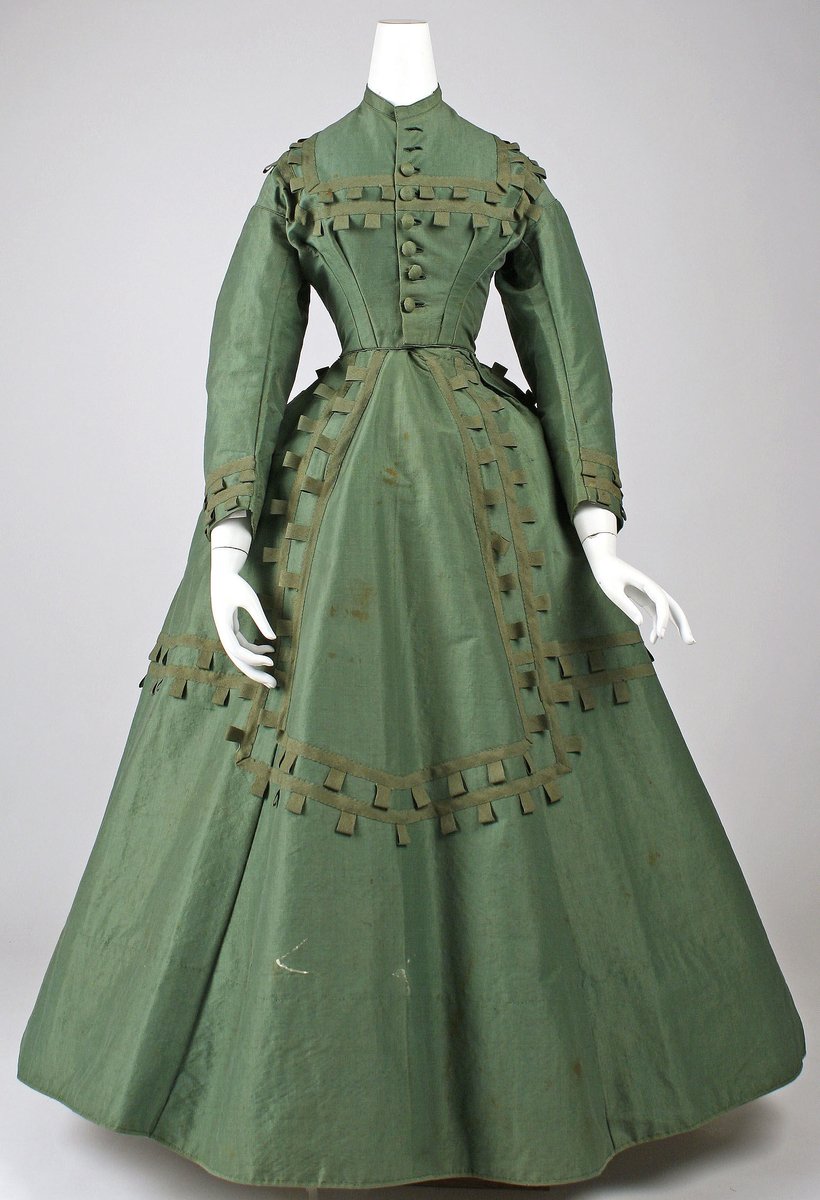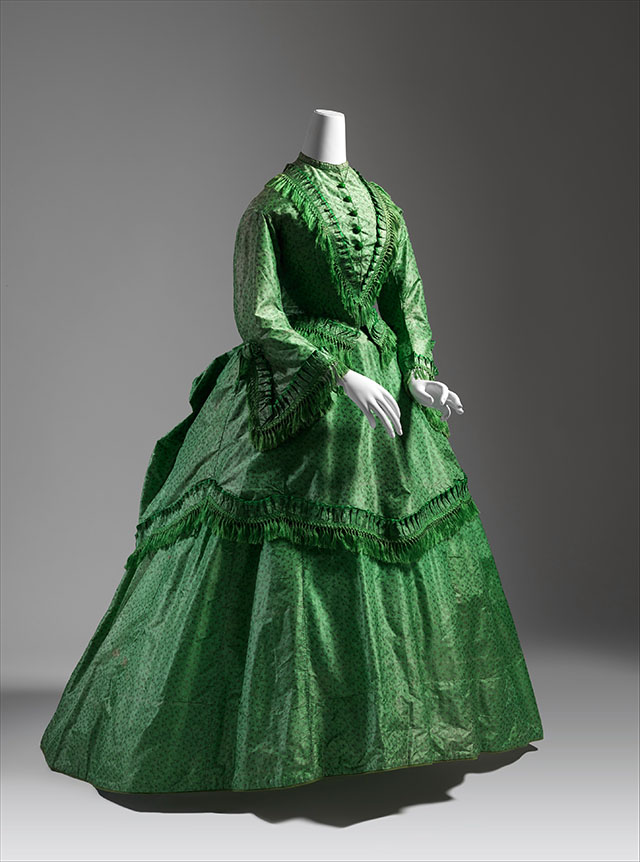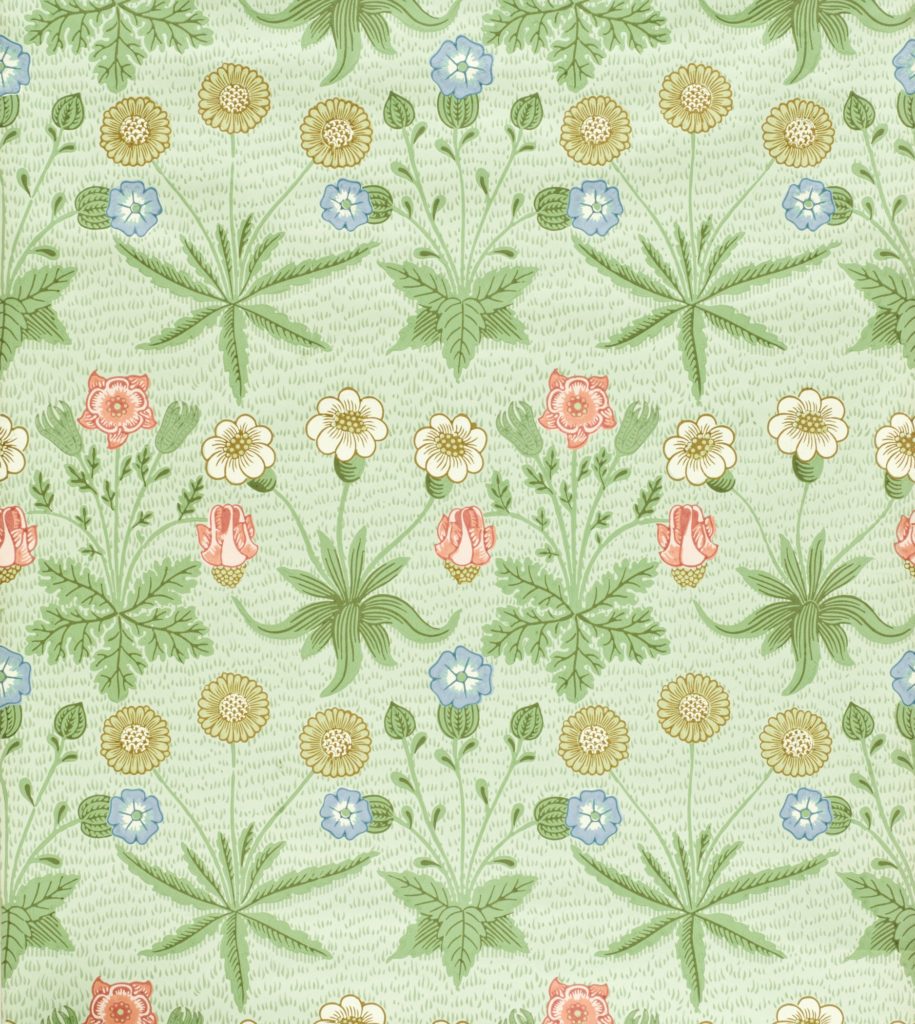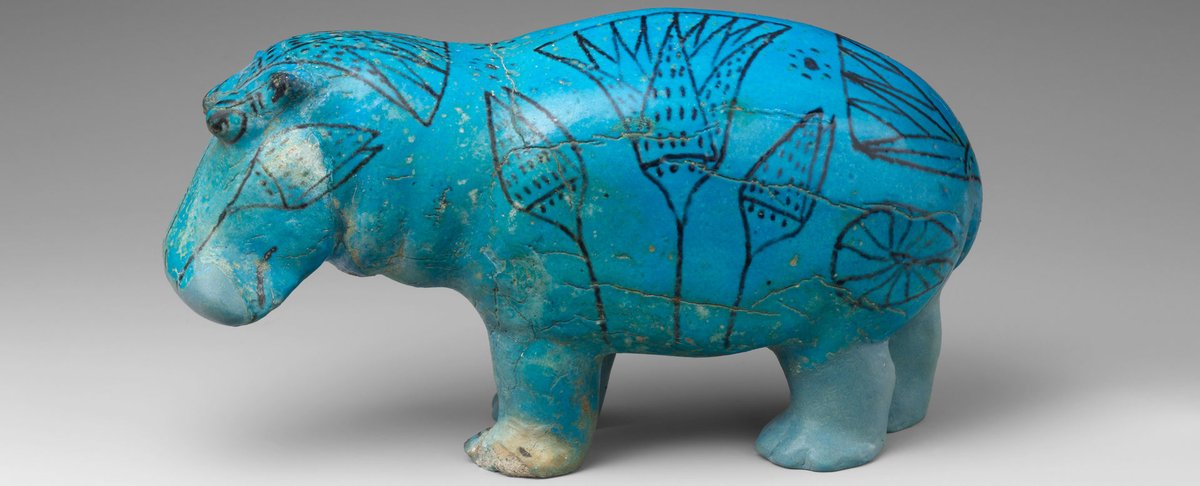
1 - It's time for #ThreadTalk. That's right: it's time to dye.
Warning: This feature includes insects🐞, poison☠️, dead bodies 💀, human combustion🔥 & general yuck🤢
And of course colonialism👎. But also gowns! Like this French afternoon dress in yellow & chartreuse from 1866
Warning: This feature includes insects🐞, poison☠️, dead bodies 💀, human combustion🔥 & general yuck🤢
And of course colonialism👎. But also gowns! Like this French afternoon dress in yellow & chartreuse from 1866

2 - Most natural fiber fabrics are bit bland at first. Getting them vibrant means the adding of pigment.
Natural wool is often an ivory hue, & it takes a lot of processing to get the right hue. Raw wool pictured below to give you an idea. Carding video:
Natural wool is often an ivory hue, & it takes a lot of processing to get the right hue. Raw wool pictured below to give you an idea. Carding video:

3 - Red is the color of passion, desire, and… insect secretion. Yes, we get carmine red from carminic acid, a substance we extract from female cochineals. Yum!
Cochineals are scale insects found in the Americas and are often found on prickly pear cactuses.

Cochineals are scale insects found in the Americas and are often found on prickly pear cactuses.


4 - Cochineals are collected by sweeping them from the plants. It goes back to the Maya and Aztec people, and became Mexico’s main import, 2nd only to silver. It was produced primarily in Oaxaca.
You can see the remarkable reds in this traditional Huipil. Also bug smacking.

You can see the remarkable reds in this traditional Huipil. Also bug smacking.


5 - Orange. Ochre can range from yellow to brown, but for the sake of ROYGBIV, it's here. Not nearly as gross as bug excretions, it's from clay. Ferric oxide, in this case, gives us that saffron hue.
It's one of the oldest pigments, and the Romans were big fans.

It's one of the oldest pigments, and the Romans were big fans.


6 - Yellow is for... urine.
Sorry, folks. But we've been using stale urine for ages due to its ammonia, & it works great to help affix dyes to wool fibers. And, like, cure *anything*, according to some.
Anyway. Here's a whiz of a video on the subject.
Sorry, folks. But we've been using stale urine for ages due to its ammonia, & it works great to help affix dyes to wool fibers. And, like, cure *anything*, according to some.
Anyway. Here's a whiz of a video on the subject.
7 - Green. I've had so many questions about this. So here we go: Green is the THE WORST. Even though you know I love green dresses.
Green dresses were actual poison. And probably killed Napoleon. We can blame Sheele's green for that.

Green dresses were actual poison. And probably killed Napoleon. We can blame Sheele's green for that.


8 - Scheele's green (sorry for the misspelling up there) is a a cupric hydrogen arsenite. As in arsenic. It was used in pigments, incl. paper flowers that *poor children* would make for hats & decoration
Thousands died
It was also used in food & as insecticide. Sorry, carmine.

Thousands died
It was also used in food & as insecticide. Sorry, carmine.


9 - Blue, Egyptian Blue. With apologies to David Bowie. AKA: cerulean (with apologies to Mulder).
One of the oldest synthetic dyes known to humankind, thanks to the Egyptians. Though the recipe was thought lost, we've determined it's a mix of silica, lime, copper, & an alkali.
One of the oldest synthetic dyes known to humankind, thanks to the Egyptians. Though the recipe was thought lost, we've determined it's a mix of silica, lime, copper, & an alkali.

10 - Egyptian blue is often used to detect traces of pigment on statues since it has such a remarkable infrared luminescence. It was also found in pots in Egyptian Tombs, and at Pompeii.
But the influence persisted & blue gowns (like this lovely) represented wealth & status.
But the influence persisted & blue gowns (like this lovely) represented wealth & status.

11 - Purple! Tyrian purple, that is. Named for Tyre, Lebanon, dating from 1200 BCE.
Here's our tie to marine biology! Because it's made from the mucus of predatory sea snails! (I swear, I can't make this shit up, and I'm a fantasy writer)
That's Charlemagne's burial shroud.

Here's our tie to marine biology! Because it's made from the mucus of predatory sea snails! (I swear, I can't make this shit up, and I'm a fantasy writer)
That's Charlemagne's burial shroud.


12 - Tyrian purple was, like, apparently attributed to being found by Hercules's dog? I don't know. Someone lost the narrative. As seen in this Rubens painting.
But who cares? I mean, purple doesn't even exist. It's not even a scientific color. It's in our heads. Seriously.

But who cares? I mean, purple doesn't even exist. It's not even a scientific color. It's in our heads. Seriously.


13 - Mauve! I have to share mauve. Because Perkin's mauve is 💯. Discovered in 1856, it became quite the sensation when the English royals started wearing it. It was the first mass-produced synthetic dye.
If you want to take a break & have some fun: collection.sciencemuseumgroup.org.uk/objects/co6783…

If you want to take a break & have some fun: collection.sciencemuseumgroup.org.uk/objects/co6783…


14 - Deep breath. Okay. We've got this.
So. Mummy brown. It was a thing.
Step 1: find mummies in Egypt (cat or human).
Step 2: dig up the mummies.
Step 3: grind up the mummies & make into paint
Step 5: profit?
Apparently one mummy could provide 20 yrs worth of pigment.

So. Mummy brown. It was a thing.
Step 1: find mummies in Egypt (cat or human).
Step 2: dig up the mummies.
Step 3: grind up the mummies & make into paint
Step 5: profit?
Apparently one mummy could provide 20 yrs worth of pigment.


15 - Now, I don't know how common it was for mummy brown to make it into clothes, but it sure did make it into paintings.
The Pre-Raphaelites were fans! Like Edward Burne-Jones. All that draping material... is... people.
Mummy brown is people.
People also ate mummy stuff. 😲
The Pre-Raphaelites were fans! Like Edward Burne-Jones. All that draping material... is... people.
Mummy brown is people.
People also ate mummy stuff. 😲

16 - White isn't a dye. But I'd be remiss not to mention that the crinoline of the 19th century was highly flammable. It would catch fire & FAST. 3,000 women died in Britain in a single year.
Just horrific. That's what. It wasn't until 1910 that we had flameproof fabrics.
Just horrific. That's what. It wasn't until 1910 that we had flameproof fabrics.

17 - How about black dye? Surely that's normal.
Well, it is one of the oldest dyes in the world & charcoal was a good option.
But what was better? BONE CHAR. Okay, tannins worked, too. And like, alder and walnut. BUT HOW GOTH IS BONE CHAR DYE?
Well, it is one of the oldest dyes in the world & charcoal was a good option.
But what was better? BONE CHAR. Okay, tannins worked, too. And like, alder and walnut. BUT HOW GOTH IS BONE CHAR DYE?

18 - I've really only begun to unspool this thread & don't have room for them all. So check this awesome infographic from @KorwinBriggs--it's got plenty of more wacky pigments.
Cinnabar? Mercury.
White? Lead.
Sepia? Octopus ink.
The list goes on and on.
Cinnabar? Mercury.
White? Lead.
Sepia? Octopus ink.
The list goes on and on.

19 - Some videos. This thread is totally dedicated to @levarburton and #ReadingRainbow -- when I saw this episode as a kid, it made me want to learn all about fabric and how to make it.
It also turned me in to a Renaissance Faire nerd.
It also turned me in to a Renaissance Faire nerd.
20 - A lovely, relaxing piece about making Iron Age dyes. I find this so soothing. Someone who just loves what they do.
21 - And one more truly relaxing, lovely video, about finding lost colors. With Sachio Yoshioka.
22 - HERE BEGINS THE SOURCES.
straw.com/sig/dyehist.ht…
blog.patra.com/2016/09/07/to-…
so-sew-easy.com/history-of-dye…
chestercohistorical.org/dress-1869-1872
racked.com/2017/3/17/1491…
pubs.acs.org/doi/pdf/10.102…
brahmsmount.com/blogs/brahms-m…
thoughtco.com/ancient-pigmen…
en.paperblog.com/the-blood-red-…
vam.ac.uk/articles/tradi…
straw.com/sig/dyehist.ht…
blog.patra.com/2016/09/07/to-…
so-sew-easy.com/history-of-dye…
chestercohistorical.org/dress-1869-1872
racked.com/2017/3/17/1491…
pubs.acs.org/doi/pdf/10.102…
brahmsmount.com/blogs/brahms-m…
thoughtco.com/ancient-pigmen…
en.paperblog.com/the-blood-red-…
vam.ac.uk/articles/tradi…
23 - Additional sources... because me.
pages.ucsd.edu/~dkjordan/cgi-…
smithsonianmag.com/science-nature…
theparisreview.org/blog/2018/05/0…
esquiremag.ph/the-good-life/…
chemistryworld.com/features/egypt…
metmuseum.org/about-the-met/…
theconservationcenter.com/articles/tyria…
pages.ucsd.edu/~dkjordan/cgi-…
smithsonianmag.com/science-nature…
theparisreview.org/blog/2018/05/0…
esquiremag.ph/the-good-life/…
chemistryworld.com/features/egypt…
metmuseum.org/about-the-met/…
theconservationcenter.com/articles/tyria…
24 - And one last batch of sources.
helenair.com/lifestyles/pri…
artinsociety.com/the-life-and-d…
fashionologiahistoriana.com/costume-histor…
refashioningrenaissance.eu/exploring-hist…
racked.com/2017/12/19/167…
messynessychic.com/2019/06/20/nig…
helenair.com/lifestyles/pri…
artinsociety.com/the-life-and-d…
fashionologiahistoriana.com/costume-histor…
refashioningrenaissance.eu/exploring-hist…
racked.com/2017/12/19/167…
messynessychic.com/2019/06/20/nig…
25 - I shall leave you with this bubblegum pink dress. Which can't have anything problematic about it. Right?
From the House of Worth, naturally. 1893, France.
Thanks for coming to my #ThreadTalk. Don't eat mummies. Please.
From the House of Worth, naturally. 1893, France.
Thanks for coming to my #ThreadTalk. Don't eat mummies. Please.

• • •
Missing some Tweet in this thread? You can try to
force a refresh

















